Sugar in Wine: Just How Much Sugar is in Wine?
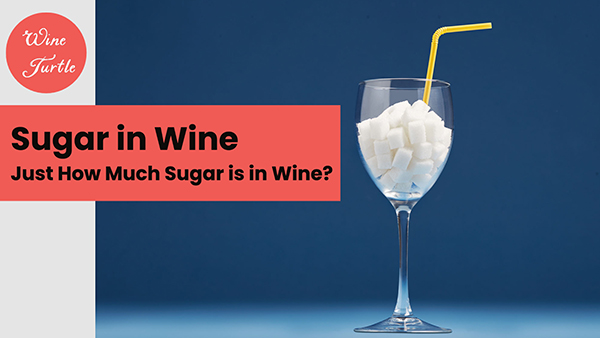
Sugar is a crucial component of wine, and understanding its role in winemaking is essential for wine enthusiasts and professionals alike.
In wine, sugar refers to the natural sugars found in grapes, which are converted into alcohol during the fermentation process.
The sugar content in wine can vary greatly depending on several factors, including the type of grape, the climate and weather conditions in which the grapes were grown, and the winemaking techniques used.
In this guide, I’ll explain the different types of sugar found in wine, how sugar content is measured, the factors that affect the sugar content in wine, and a whole lot more!
What is Sugar in Wine?
Firstly, sugar in wine is primarily derived from the grapes themselves. Grapes, through the process of photosynthesis, naturally accumulate sugars in the form of glucose and fructose. These sugars are found in the grape's juice, which serves as the base for winemaking.
These sugars have two main fates. In the most traditional scenario, yeast is added to the grape juice in a process known as fermentation. The yeast consumes the sugars, converting them into alcohol and carbon dioxide. The result is what we call a dry wine, meaning it contains very little residual sugar, if any.
But not all sugars always get converted. In some cases, winemakers might stop the fermentation process before the yeast has consumed all of the sugar.
The sugar that remains in the wine is referred to as residual sugar, and this gives the wine a certain level of sweetness. Depending on the amount of residual sugar left, wines can be classified as off-dry, semi-sweet, or sweet.
Sweetness in wine is not solely the domain of dessert wines like Sauternes or Port. Many popular wines, like Moscato d'Asti or certain styles of Riesling, are appreciated for their delicate balance of sweetness and acidity.
Even some Champagnes and sparkling wines, often thought of as dry, can contain a surprising amount of residual sugar.
The perception of sweetness is also influenced by other components in wine, such as acidity, tannins, and alcohol. A wine with high acidity can taste less sweet than its sugar content might suggest, while a wine with high alcohol can taste sweeter.
In the realm of winemaking, sugar can also be added artificially, a practice known as chaptalization. This doesn't necessarily make the wine sweet. Instead, it increases the potential alcohol content in the final product, as the added sugar is typically fully converted to alcohol during fermentation.
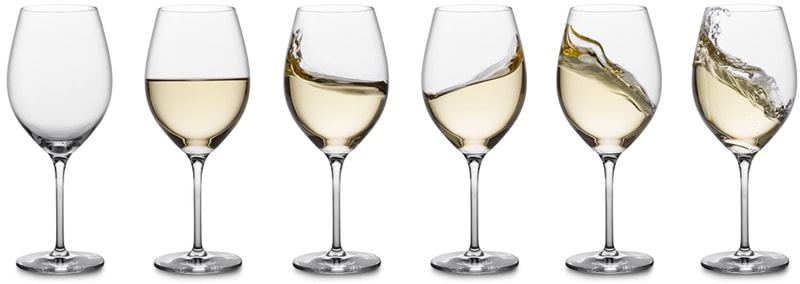
Types of Sugar Found in Wine
Understanding the different types of sugar found in wine is essential for understanding how sugar affects the taste and quality of wine.
1. Glucose
Glucose is the most abundant sugar found in grapes and the primary source of energy for yeast during the fermentation process. When yeast consumes glucose, it converts it into alcohol and carbon dioxide.
2. Fructose
Fructose is another simple sugar found in grapes, but it is less abundant than glucose. It is sweeter than glucose and can contribute to the sweetness of wine.
3. Sucrose
Sucrose is a complex sugar made up of glucose and fructose molecules bonded together. It is less abundant in grapes than glucose and fructose, but it can still contribute to the sweetness of wine.
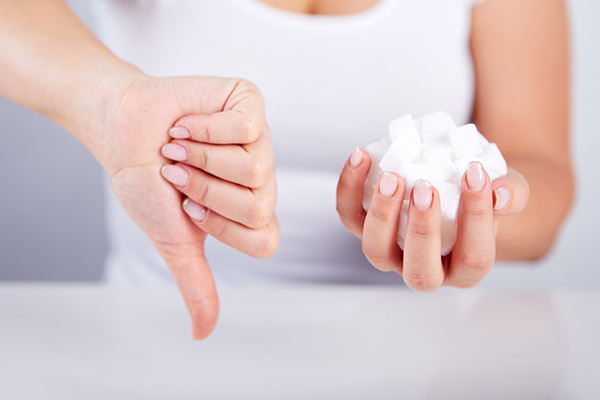
How Does the Sugar in Wine Relate to its Calorie Content?
The relationship between residual sugar in wine and calories is not straightforward, as it depends on various factors such as the type of sugar, the fermentation process, and the presence of other components in the wine.
However, a study titled "Characteristics of beer brewed with unconventional yeasts and addition of grape must, pulp and marc" provides some insights into this topic.
The study found that the amount of residual sugar in wine (or beer in this case) can impact the caloric content (residual sugar refers to the sugar remaining after the fermentation process).
During fermentation, yeast consumes sugar and produces alcohol. If not all sugar is consumed during fermentation, the remaining sugar contributes to the wine's sweetness and also adds to the caloric content.
The study also noted that the type of yeast used in fermentation can impact the amount of residual sugar. Some yeast strains are more efficient at consuming sugar, which can result in a lower residual sugar content and potentially fewer calories. However, the study did not provide a specific conversion factor for how much residual sugar translates into calories.
It's important to note that while sugar does contribute to the caloric content of wine, it's not the only factor. Alcohol itself is calorie-dense, contributing approximately 7 calories per gram. Therefore, a wine with a higher alcohol content may have more calories, even if it has less residual sugar.
To get a precise understanding of the caloric content of a specific wine, it would be necessary to have detailed information about its composition, including both sugar and alcohol content.
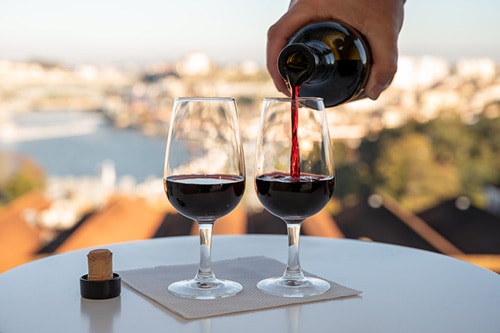
Role of Sugar in the Winemaking Process
The amount of sugar present in grapes can significantly impact the fermentation process and the resulting alcohol content.
Essentially, the more sugar there is the higher the potential ABV of the resulting wine.
Fermentation begins when yeast is introduced to grape must – the freshly crushed grape juice that contains skins, seeds, and stems. The yeast, a tiny but powerful organism, starts to consume the sugar present in the juice.
During this process, the yeast breaks down the sugar into alcohol (ethanol), carbon dioxide, and heat. This is the primary method through which wine gains its alcohol content.
The amount of sugar in the grape must at the start of fermentation, known as the Brix level, largely determines the potential alcohol level of the finished wine. If all the sugar is fermented, a higher initial sugar level will result in a higher alcohol content.
This is why grapes from warmer climates, which typically develop higher sugar levels, can produce wines with higher alcohol content.
However, not all sugars are always fully converted into alcohol. Winemakers can choose to stop the fermentation process early, leaving some residual sugar in the wine. This results in a wine that is less alcoholic and more sweet, and it is a common practice in the production of off-dry or sweet wines.
On the other hand, if a must is too high in sugar, it can actually inhibit the yeast's activity. Yeast cells can only tolerate a certain level of alcohol around them, generally up to 15-16% for most strains.
Beyond this, the yeast may die or become dormant before all the sugar is consumed, leaving a high level of residual sugar and a wine that is both sweet and high in alcohol.
How Sugar Content in Wine is Measured
The sugar content in wine is measured using a tool called a refractometer.
A refractometer measures the amount of sugar in a liquid by measuring the refractive index, which is the degree to which light is bent as it passes through the liquid.
The refractive index of a liquid is directly proportional to the amount of sugar present in the liquid.
The sugar content in wine is measured in two different units: Brix and Baumé.
Brix is the most commonly used unit for measuring sugar content in wine.
One degree Brix is equivalent to 1 gram of sugar per 100 grams of liquid.
Baumé is another unit of measurement used to measure sugar content in wine, but it is not as commonly used as Brix.
A hydrometer may also be used to track fermentation and how much sugar remains in a wine. It works using the concepts of density and buoyancy.
Essentially, the more sugar remains the more dense the liquid will be and the more buoyant the hydrometer will be on its surface.
Factors that Affect the Sugar Content in Wine
To appreciate the factors that affect the sugar content in wine, we need to consider the journey from vine to bottle, a narrative steeped in the influences of climate, viticultural practices, and winemaking decisions.
Comparison of Sugar Content in Different Types of Wine
To give you an idea of the range, here are some typical sugar levels for various styles of wine, measured in grams per liter (g/L):
These are general ranges and there can be considerable variation within each category. Always remember that the perception of sweetness isn't just about sugar - acidity, tannins, and alcohol can all influence how sweet a wine tastes.
Sugar Content of Popular Wines
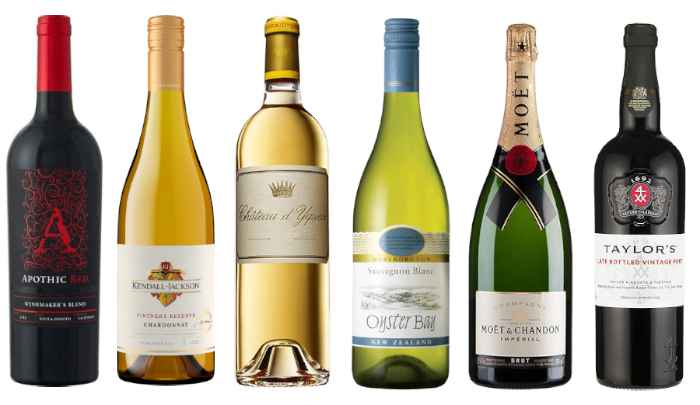
It can be hard to find the sugar content on wine bottles as some winemakers aren’t required required to display it.
But these figures will give you a general idea:
It's important to note that the exact sugar content can vary from vintage to vintage and between different bottlings from the same producer due to differences in grape ripeness and winemaking techniques.
Note, the bigger and better wineries out there will always provide tech sheets for their wines that will include residual sugar. You can usually find these on the winery websites.
The Relationship Between Sugar and Taste in Wine
The influence of sugar on a wine extends beyond simply making a wine taste "sweet" – it can affect the overall balance, mouthfeel, and even the aging potential of a wine.
Let's take a look at the 'bigger picture' when it comes to the role of sugar in a wine. Here's how it relates to our overall perception and appreciation of a wine.
1. Perception of Sweetness: The most direct relationship between sugar and taste in wine is the perception of sweetness.
Residual sugar, the sugar left in wine after fermentation, can lend a sweetness to the wine's taste, ranging from barely detectable in off-dry wines to the pronounced sweetness of dessert wines.
2. Balance: Sugar plays a vital role in balancing other elements in a wine, particularly acidity and tannins. Acidity can make a wine taste crisp and refreshing, but too much can lead to a wine that tastes harshly sour.
Sugar can help soften the impact of high acidity. Similarly, tannins – compounds found in grape skins, seeds, and stems – can give wine a bitter or astringent taste. A little sweetness can help counteract these bitter notes.
3. Body and Mouthfeel: Sugar contributes to the body and mouthfeel of a wine. Wines with higher residual sugar tend to have a fuller body and a richer, more viscous mouthfeel. This is why sweet wines often feel "heavy" or "dense" in the mouth, while dry wines feel "light" or "medium-bodied."
Aging Potential: Interestingly, sugar can also affect a wine's ability to age. Sweet wines with high sugar content, like Sauternes or Tokaji, are known for their remarkable longevity. The high sugar levels act as a preservative, allowing these wines to develop complex flavors over many years, or even decades.
However, it's important to note that the taste of wine is not determined by sugar alone. The presence of alcohol, acids, tannins, and various aroma compounds also significantly contribute to our perception of wine. The magic of a great wine lies in the harmonious balance of all these elements.
Confusing Fruitiness for Sweetness in Wine
The perception of taste in wine is a complex and fascinating topic, and the intersection of 'dry' and 'fruity' is a prime example.
Despite the seeming contradiction, a dry wine – one with minimal residual sugar after fermentation – can indeed taste sweet due to its pronounced fruit flavors.
This perceived sweetness is mainly due to our brain's association between sweet flavors and ripe fruits. When we eat ripe fruits, we taste sweetness from the fruit's natural sugars.
This sweetness is usually accompanied by specific aromatic compounds that give the fruit its distinctive flavor. Over time, our brains associate these aromas with sweetness.
Wine, especially those made from very ripe grapes, can contain many of these same aromatic compounds. For instance, a dry Riesling might have aromas of ripe peaches or a Merlot might have notes of black cherries.
When we smell these fruity aromas while tasting the wine, our brains may expect sweetness, leading to a perception of sweetness even in the absence of significant sugar.
Other factors can also contribute to the perception of sweetness in a dry wine. For instance, a wine's alcohol content can provide a slight sweetness, as alcohol has a sweet taste.
Likewise, the use of new oak barrels in the winemaking process can impart flavors such as vanilla or caramel, which are typically associated with sweetness.
